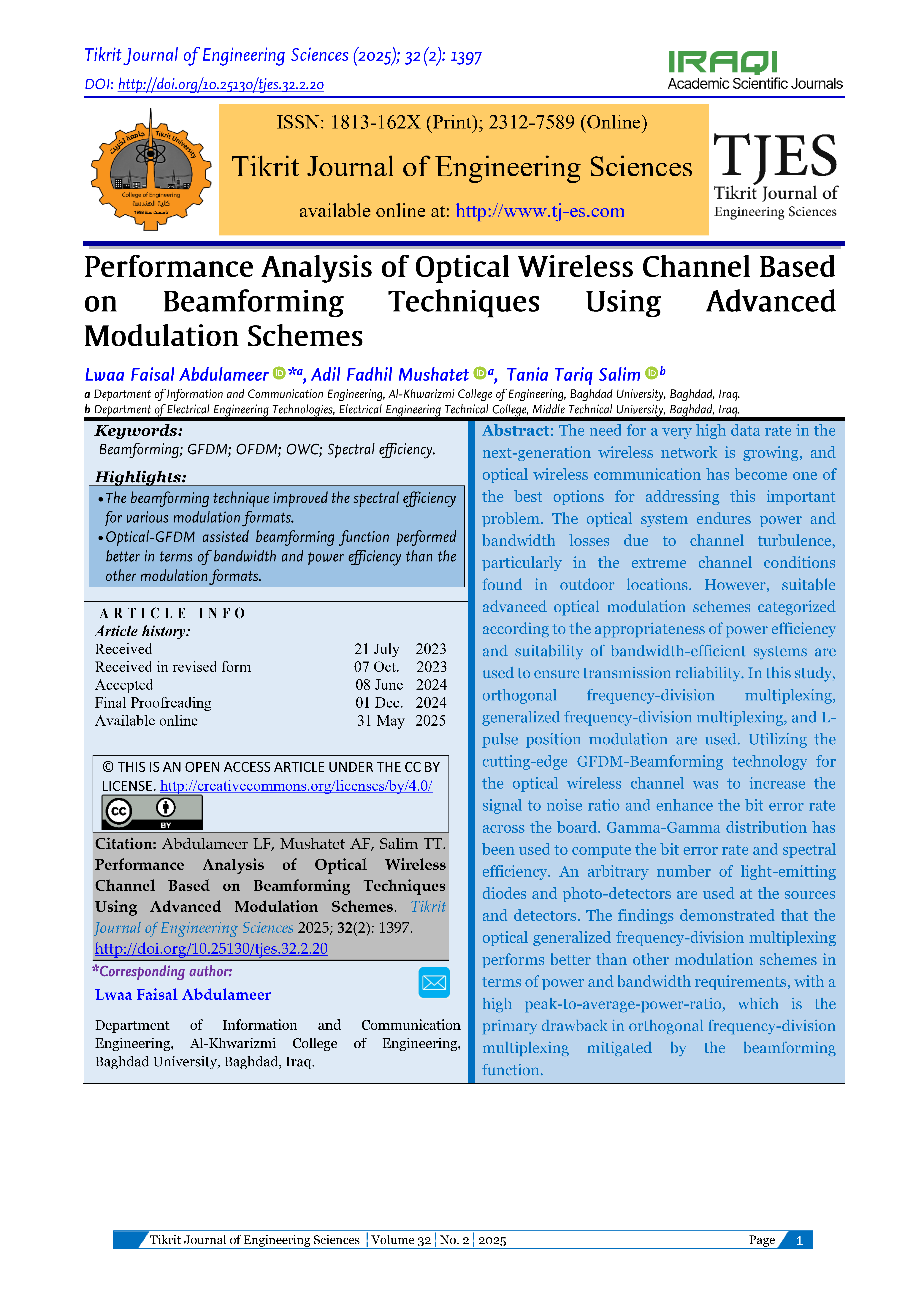Performance Analysis of Optical Wireless Channel Based on Beamforming Techniques Using Advanced Modulation Schemes
Main Article Content
Abstract
The need for a very high data rate in the next-generation wireless network is growing, and optical wireless communication has become one of the best options for addressing this important problem. The optical system endures power and bandwidth losses due to channel turbulence, particularly in the extreme channel conditions found in outdoor locations. However, suitable advanced optical modulation schemes categorized according to the appropriateness of power efficiency and suitability of bandwidth-efficient systems are used to ensure transmission reliability. In this study, orthogonal frequency-division multiplexing, generalized frequency-division multiplexing, and L-pulse position modulation are used. Utilizing the cutting-edge GFDM-Beamforming technology for the optical wireless channel was to increase the signal to noise ratio and enhance the bit error rate across the board. Gamma-Gamma distribution has been used to compute the bit error rate and spectral efficiency. An arbitrary number of light-emitting diodes and photo-detectors are used at the sources and detectors. The findings demonstrated that the optical generalized frequency-division multiplexing performs better than other modulation schemes in terms of power and bandwidth requirements, with a high peak-to-average-power-ratio, which is the primary drawback in orthogonal frequency-division multiplexing mitigated by the beamforming function.
Metrics
Article Details

This work is licensed under a Creative Commons Attribution 4.0 International License.
THIS IS AN OPEN ACCESS ARTICLE UNDER THE CC BY LICENSE http://creativecommons.org/licenses/by/4.0/
Plaudit
References
Paramjot S, Harmandar K. Analysis of FSO Based ROF-WDM System with Advance Intensity Modulation Techniques under Various Atmospheric Conditions. 2nd International Conference on Electronics, Communication and Aerospace Technology (ICECA) 29-31 March 2018; Coimbatore, India: p. 445-449. DOI: https://doi.org/10.1109/ICECA.2018.8474722
Nawaf SF. Channel Capacity Improvement of MIMO Communication Systems using Different Techniques. Tikrit Journal of Engineering Sciences 2018; 25 (1): 36–41. DOI: https://doi.org/10.25130/tjes.25.1.06
Noor K, Walid A, Falah H, Israa M. Efficient Resource Allocation for Wireless-Powered MIMO-NOMA Communications. IEEE Access 2022; 10: 130302-130313. DOI: https://doi.org/10.1109/ACCESS.2022.3228754
Maha M, Saad M, Asmaa S. A New Transmission and Reception Algorithms for Improving the Performance of SISO/MIMO- OFDM Wireless Communication System. Tikrit Journal of Engineering Sciences 2021; 28 (3): 146–158. DOI: https://doi.org/10.25130/tjes.28.3.11
Esam M, Mohammed T. Error Analysis of NOMA-Based VLC Systems with Higher Order Modulation Schemes. IEEE Access 2020; 8: 2792-2803. DOI: https://doi.org/10.1109/ACCESS.2019.2962331
Samir A, Mohd F, Ali A, Redhwan Q, Usman U, Nasir A, Tarik A. A Survey of Free Space Optics (FSO) Communication Systems, Links, and Networks. IEEE Access 2020; 9: 7535-7373. DOI: https://doi.org/10.1109/ACCESS.2020.3048049
Layla M, Thuraya M, Jalal J. Performance Analysis of Different Flexible Decoding Algorithms for NR-LDPC Codes: Performance Analysis. Tikrit Journal of Engineering Sciences 2022; 29 (4): 10–18. DOI: https://doi.org/10.25130/tjes.29.4.2
Yue Y, Miao L, Guan G, Hikmet S. Resource Allocation for UAV-Assisted MIMO-NOMA Wireless Caching Networks. IEEE 21st International Conference on Software Quality, Reliability and Security Companion (QRS-C) 2021; Hainan, China: p. 1006-1010.
Erik G, Edfors O, Fredrik T, Thomas L. Massive MIMO for Next Generation Wireless Systems. IEEE Communications Magazine 2014; 52 (2):186-195. DOI: https://doi.org/10.1109/MCOM.2014.6736761
Ahmed T, Mohammad T, Ahmed H, Hasanain N, Ali M, Farah A. Performance Evaluation of Wireless Data Traffic in Mm Wave Massive MIMO Communication. Indonesian Journal of Electrical Engineering and Computer Science 2020; 20 (3): 1342-1350. DOI: https://doi.org/10.11591/ijeecs.v20.i3.pp1342-1350
Gassemlooy Z, Popoola W, Rajbhandari S. Optical Wireless Communications: System and Channel Modelling with MATLAB. 2nd ed., Florida, USA: CRC Press, Taylor & Francis Group; 2018. DOI: https://doi.org/10.1201/9781315151724
Israa H, Ayad A. Energy-Efficient Massive MIMO Network. Tikrit Journal of Engineering Sciences 2023; 30 (3):1-8. DOI: https://doi.org/10.25130/tjes.30.3.1
Muhammad S, Gucluoglu T. Maximum Ratio Transmission Based Generalized Frequency Division Multiplexing Over Gamma-Gamma Channel. Optical Communications 2021; 492: 1-8. DOI: https://doi.org/10.1016/j.optcom.2021.126965
Wilson S, Brandt-Pearce M, Qianling C, Leveque J. Free-Space Optical MIMO Transmission with Q-ary PPM. IEEE Transactions on Communications 2005; 53 (8): 1402–1412. DOI: https://doi.org/10.1109/TCOMM.2005.852836
Björnson E, Hoydis J, Sanguinetti L. Massive MIMO Networks: Spectral, Energy, and Hardware Efficiency. 1st ed., Now Foundations and Trends; 2017. DOI: https://doi.org/10.1561/2000000093
Wan J, Hongzhan L, Jianjun Y, Zhongchao W, Aiping L, Dongmei D. Performance of a QAM/FSO Communication System Employing Spatial Diversity in Weak and Saturation Turbulence Channels. Journal of Modern Optics 2019; 66 (9): 965–975. DOI: https://doi.org/10.1080/09500340.2019.1596321
Al-Nahhal M, Tawfik I. Enhancing Spectral Efficiency of FSO System Using Adaptive SIM/M-PSK and SIMO in the Presence of Atmospheric Turbulence and Pointing Errors. International Journal of Communication Systems 2019; 32 (9): 1-12. DOI: https://doi.org/10.1002/dac.3942
Anshul J, Manav R, Virander K. Performance Evaluation of Space Shift Keying in Free-Space Optical Communication. Journal of Optical Communications and Networking 2017; 9 (2):149–160. DOI: https://doi.org/10.1364/JOCN.9.000149
Seung-Hoon H, Yan C. SIM/SM-Aided Free-Space Optical Communication with Receiver Diversity. Journal of Lightwave Technology 2014; 32 (14):2443–2450. DOI: https://doi.org/10.1109/JLT.2014.2327078
Kehinde O, Pius A, Viranjay M. Performance Analysis of Free Space Optical System with Spatial Modulation and Diversity Combiners Over the Gamma Gamma Atmospheric Turbulence. Optics Communications 2017; 382:205–211. DOI: https://doi.org/10.1016/j.optcom.2016.07.072
Hien T, Ngoc T. Performance Improvement of Spatial Modulation-Assisted FSO Systems over Gamma–Gamma Fading Channels with Geometric Spreading. Photonic Network Communications 2017; 34 (2): 213–220. DOI: https://doi.org/10.1007/s11107-017-0685-0
Chien-Chun C, Hikmet S, Serdar S, Yu T. Enhanced Spatial Modulation with Multiple Signal Constellations. IEEE Transactions on Communications 2015; 63 (6): 2237–2248. DOI: https://doi.org/10.1109/TCOMM.2015.2422306
Lwaa F, Sripati U, Muralidhar K. BER Performance Improvement of Dual Chaotic Maps Based on STBC Communication System. Al-Khwarizmi Engineering Journal 2022; 18 (4):32-44. DOI: https://doi.org/10.22153/kej.2022.10.001
Lwaa F, Tabarek A. Performance Analysis for Hybrid Massive MIMO FSO/RF Links Based on Efficient Channel Codes. International Journal of Intelligent Engineering and Systems 2021; 6 (14):333-343. DOI: https://doi.org/10.22266/ijies2021.1231.30





